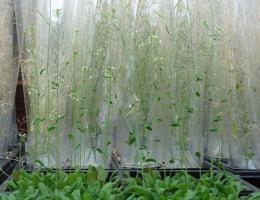
Features
Business
Research
Examining the molecular basis of plant immune response
February 17, 2010 By Texas A&M
Feb. 17, 2010 College Station, TX – Basic research on the biological
signaling systems of plants could lead to “souped-up” plant immune systems,
said Dr. Ping He, a Texas AgriLife Research scientist.
Feb. 17, 2010 College Station, TX – Basic research on the biological
signaling systems of plants could lead to “souped-up” plant immune systems,
said Dr. Ping He, a Texas AgriLife Research scientist.
“Differential innate immune signalling via Ca2+ sensor protein kinases”
was published Jan. 17 in Nature, a prominent scientific journal. The
article describes a mechanism discovered by a collaborative team that includes Dr. Ping He, with the Texas A&M University department of biochemistry and
biophysics, and Dr. Libo Shan,Texas A&M department of plant
pathology and microbiology.
Other members of the team included Dr. Marie Boudsocq, Institut des
Sciences du Végétal, France; Dr. Matthew R. Willmann, department of biology,
University of Pennsylvania; and Drs. Matthew McCormack, Horim Lee, Jenifer
Bush, and Jen Sheen, all of the Harvard Medical School department of genetics.
It’s long been known that both plants and animals react to microbials by
first recognizing them as foreign, then launching cascades of immune responses
to fend off the attack, Dr. He explained. Both kingdoms recognize the microbes
by their molecular patterns, then use a very complex system of enzymes and
intracellular processes to boost the natural immune response.
It’s also known, He said, that calcium ions are used as a kind of
messenger in this signaling process to activate cellular proteins. But exactly
how calcium ions were sensed and relayed in the process was a mystery.
To try to solve this mystery, the research team used Arabidopsis, a small
flowering plant in the same family as cabbage and mustard. It is often used in
such studies because it was one of the first plants to have its entire genome mapped,
He said.
 |
| To examine how plant immune systems work, a team of scientists that include Texas AgriLife Research scientists used Arabidopsis, a small flowering plant in the same family as cabbage and mustard. Arabidopsis is often used in such studies because it was one of the first plants to have its entire genome mapped, according to Dr. Ping He, with the Texas A&M University department of biochemistry and biophysics. (Texas AgriLife Research photo) |
The team found four calcium-dependent enzymes were critical to plants’
immune system response. All four enzymes were involved in the plant cells
synthesizing defense mechanisms such as peptides and other metabolites to fight
microbial threats.
To understand how the calcium-dependent process worked, team members
developed a new technology called “protoplast transient assay.” Protoplasts are
naked plant cells without cell walls, a characteristic that makes it easier to
introduce foreign genes into plant cells for study, He said.
“The results clearly suggested that specific calcium dependent processes
are central regulators in integrating multiple signaling pathways,” he said.
“The identified calcium kinases (enzymes) have great potential to improve plant
resistance to multiple pathogens, including bacteria, fungi and phytophthora.”
There were some surprises along the way. For example, neither a common
toxin associated with gram-negative bacteria (LPS) or a component of the
bacteria cell wall (PGN), elicited what the researchers considered a
“stereotypical” immune response, He said. Instead, it would seem that a
relatively few target genes were the same.
“This was presumably due to (the toxins) eliciting distinct Ca2+ (calcium
ion) dependent signatures,” He said.
Different toxins or microbial signals stimulate slightly different
defense responses. Some are quicker, others are stronger, and still others are
longer-lasting. This was thought due to the distinct signatures elicited by
different toxins, He said.
“It has long been known that calcium-dependent kinases function upstream
of another group of evolutionarily conserved proteins called MAPK in animals,”
He said. “However, the new study suggests that calcium kinases (enzymes) and
MAPK (mitogen-activated protein kinases) can function in parallel in a cell.”
“Evolutionarily conserved” means enzymes such as MAPK have a common
evolutionary origin among both the plant and animals,” He explained.
He said this discovery suggests there are more genetic tools to
manipulate plants and animals for beneficial characteristics that previously
suspected.
“I feel this was an exciting surprise,” He said.
Print this page